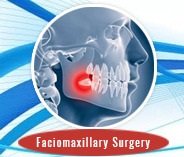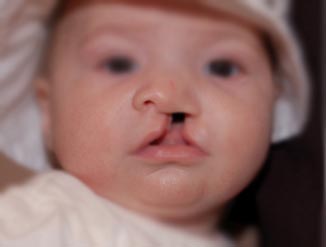Orofacial clefts are birth defects in which there is an opening in the lip and/or palate (roof of the mouth) that is caused by incomplete development during early foetal formation. Cleft lip and cleft palate occurs when parts of the lip or palate do not completely fuse together during the first 3 months of pregnancy. A cleft lip may appear as a small notch in the edge of the lip only or extend into the nose. It may also extend into the gums.
A cleft palate may also vary in size, from a defect of the soft palate only to a complete cleft that extends through the hard palate. Because the lips and the palate develop separately, it is possible for a child to be born with a cleft lip only, cleft palate only, or both. The good news is that both cleft lip and cleft palate are treatable by facial surgery. Most kids born with these can have surgery to repair these defects within the first 12-18 months of life.
Most clefts can be categorized into three broad categories:
- Cleft lip without a cleft palate
- Cleft palate without a cleft lip
- Cleft lip and cleft palate together
A cleft can occur on one side of the mouth (unilateral cleft) or on both sides of the mouth (bilateral cleft). Cleft lip with or without cleft palate is generally more common among boys; however, cleft palate occurring alone is more common in girls than boys.
Causes
Sometimes a cleft occurs as part of a syndrome, meaning there are birth defects in other parts of the body, too. Other times, it’s genetic and runs in families //? the risk may be higher for children whose sibling(s) or parents have a cleft or who have a history of cleft in their families. In these situations, both mothers and fathers can pass on a gene or genes that can contribute to the development of cleft lip or cleft palate.
Sometimes a cleft may be associated with environmental factors such as a woman’s use of certain medications, exposure to cigarette smoke, or lack of certain vitamins while pregnant. However, most of the time, the cause is unknown.
Problems Associated With Cleft Lip and/or Cleft Palate
Eating problems: With a separation or opening in the palate, food and liquids can pass from the mouth back through the nose. Fortunately, specially designed baby bottles that help keep fluids flowing downward towards the stomach are available. Children with a cleft palate may need to wear a man-made palate to help them eat properly and ensure that they are receiving adequate nutrition until surgical treatment is provided.
Ear infections/hearing loss: Children with cleft palate are at increased risk of ear infections since they are more prone to fluid build-up in the middle ear. If left untreated, ear infections can cause hearing loss. To prevent this from happening, children with cleft palate usually need special tubes placed in the eardrums to aid fluid drainage, and their hearing needs to be checked once a year.
Speech problems: Children with cleft lip or cleft palate may also have trouble speaking. These children’s voices don’t carry well, the voice may take on a nasal sound, and the speech may be difficult to understand. Not all children have these problems and surgery may fix these problems entirely for some. For others, a special doctor, called speech pathologist, will work with the child to resolve speech difficulties.
Dental Problems: Children with clefts are more prone to a larger than average number of cavities and often have missing, extra, malformed, or displaced teeth requiring dental and orthodontic treatments. In addition, children with cleft palate often have an alveolar ridge defect. The alveolus is the bony upper gum that contains teeth. A defect in the alveolus can (1) displace, tip, or rotate permanent teeth, (2) prevent permanent teeth from appearing, and (3) prevent the alveolar ridge from forming. These problems can usually be repaired through oral surgery.
Treatment – Surgery for Cleft Lip and Palate
A cleft lip may require one or two lip surgeries depending on the extent of the repair needed. The initial surgery is usually performed by the time a baby is 3 months old. Repair of a cleft palate often requires multiple cleft repair surgeries over the course of 18 years. The first surgery to repair the palate usually occurs when the baby is between 6 and 12 months old. The initial surgery creates a functional palate, reduces the chances that fluid will develop in the middle ears, and aids in the proper development of the teeth and facial bones.
Children with a cleft palate may also need a bone graft when they are about 8 years old to fill in the upper gum line so that it can support permanent teeth and stabilize the upper jaw. About 20% of children with a cleft palate require further surgeries to help improve their speech. Once the permanent teeth grow in, braces are often needed to straighten the teeth.
Additional surgeries may be performed to improve the appearance of the lip and nose, close openings between the mouth and nose, help breathing, and stabilize and realign the jaw. Final repairs of the scars left by the initial surgery will probably not be performed until adolescence, when the facial structure is more fully developed.
















